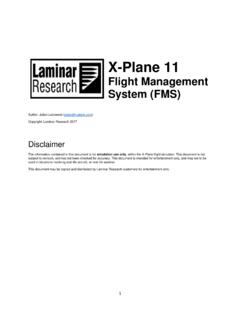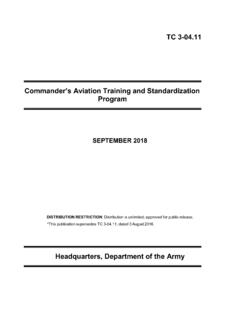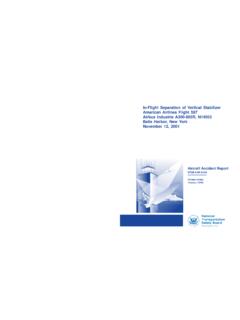Transcription of Aviation Instructor's Handbook (FAA-H-8083-9)
1 Aviation Instructor's Handbook (FAA-H-8083-9) Chapter 9: Techniques of flight Instruction Introduction flight instructor Daniel decides his learner, Mary, has gained enough confidence and experience that it is time for her to develop personal weather minimums.
2 While researching the subject at the Federal Aviation Administration (FAA) website, he locates several sources that provide background information indicating that weather often poses some of the greatest risks to general Aviation (GA) pilots, regardless of their experience level. He also finds charts and a lesson plan he can use. Daniel s decision to help Mary develop personal weather minimums reflects a key component of the flight instructor s job: providing the learner with the tools to ensure safety during a flight . What does safety really mean?
3 How can a flight instructor ensure the safety of flight training activities, and also train clients to operate their aircraft safely after they leave the relatively protected flight training environment? According to one definition, safety is the freedom from conditions that can cause death, injury, or illness; damage to loss of equipment or property, or damage to the environment. FAA regulations are intended to promote safety by eliminating or mitigating conditions that can cause death, injury, or damage.
4 These regulations are comprehensive but instructors recognize that even the strictest compliance with regulations may not guarantee safety. Rules and regulations are designed to address known or suspected conditions detrimental to safety, but there is always the possibility that a combination of hazardous circumstances will arise. The recognition of Aviation training and flight operations as a system led to a system approach to Aviation safety. This chapter discusses some of the practices found to make flight safer on a systemic basis including aeronautical decision-making (ADM), risk management , situational awareness, and single-pilot resource management (SRM).
5 These components should be included in a modern flight training program. Practical flight Instructor Strategies During all phases of flight training, instructors should remember that individuals learn through observing others; therefore, the instructor needs to model safe and professional behavior. The flight instructor should demonstrate good operational sense at all times: Before the flight discuss safety and the importance of a proper preflight and use of the checklist. During flight prioritize the tasks of aviating, navigating, and communicating.
6 Instill importance of aircraft control, see and avoid, situational awareness, and workload management in the learner. During landing conduct stabilized approaches, maintain desired airspeed on final, demonstrate good judgment for go-arounds, wake turbulence, traffic, and terrain avoidance. Correct faulty approaches and landings. Make touchdowns on the centerline in the first third of the runway. After the flight review or discuss flight events and choices using ADM principles. Plan a remediation if trends indicate an inadequate skill, a hazardous attitude, or inadequate knowledge of risk mitigation.
7 flight instructors should produce safe pilots. For that reason, instructors should encourage each learner to learn as much as possible. When introducing lesson tasks, flight instructors should not focus on the minimum acceptable standards for passing the checkride. The ACS/PTS is not a teaching tool. It is a testing tool. The overall focus of flight training should be on education, learning, and understanding why the standards are there and how they were set. The completion standards for each lesson should gradually reach or exceed those in the ACS/PTS before final preparation for the checkride.
8 Integrating Instruction Techniques A flight instructor uses many instructional techniques during ground instruction, when using simulation, and during hands-on aircraft training. Since flight training costs are high and new aircraft are more complex than in the past, the total training experience should provide a solid base of knowledge and maximize the learner s time without sacrificing the quality of the end product. This section looks at teaching techniques in greater detail. 9-1 Ground Instruction Ground instruction can be highly effective if it follows an overall plan designed to prepare the learner for flight .
9 In Chapter 7, Planning Instructional Activity, Figure 7-2 shows a ground lesson that includes clear objectives. However, ground training objectives should be related to flight training objectives whenever possible. When elements are taught on the ground (as theory), their practice and application is also experienced in the air. The instructor should point out the connection between the theory and practice to maximize the benefit from integrated ground and flight instruction. [Figure 9-1] Additionally, ground instruction need not be in the classroom for maximum effectiveness.
10 For example, conduct a preflight using an actual aircraft although initially taught in an academic setting. Additionally, when airspace is being taught an invaluable reinforcement of training includes taking the learners to ATC facilities where they can see management of the National Airspace System (NAS) from another perspective. Figure 9-1. The learner prepares to execute a power-off stall maneuver in- flight that was taught in ground school. Studies have shown that a mix of instructional elements provides the best balance during ground instruction.
















